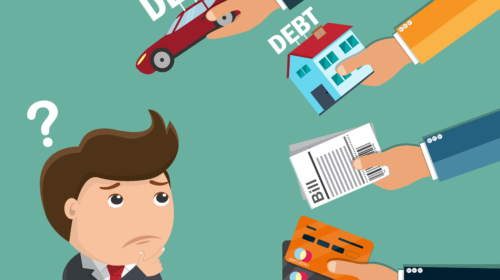Good Debt, Bad Debt, and Electronic Payments

Before you sign up for another streaming content or food delivery service, consider this: Debt-to-income (DTI) ratios have shifted dramatically in recent years, with the average American household earning $61,372 annually while owing an unprecedented, faster-growing $137,063[1]. By comparison, the median income in 2000 was just $42,000, but with much less due. Back then, median household debt only averaged $50,971.
This shift correlates with the widespread adoption of electronic payment options, which now include mobile wallets and wearables that let you pay for anything anywhere– without physically interacting with your money or even its plastic counterpart. Sometimes a simple click can automate years’ worth of recurring payments. The simultaneous rise of electronic payment methods and household debt might be more than mere coincidence.
“Among consumers, good debt is increasingly morphing into bad debt as borrowers outspend their increased earnings,” explains Jim Rogers, Jr., Managing Partner at Haefele Flanagan. “I believe that the ability to pay easily or even unknowingly is separating us from the reality of our spending habits – which can have dire consequences.”
For households, good debt is generally classified as monthly financial obligations totaling less than thirty percent of monthly revenue.
“That thirty percent includes car debt, credit card debt, and even expenditures sometimes falsely characterized as good– namely, mortgages and student loan debt,” Rogers says. “These were traditionally paid for via cash or handwritten checks, or via credit card information entered once per transaction. These necessary steps required physical effort and a moment’s awareness of the deduction at hand. Today, payments are more likely to be deducted automatically – which can cause payer to underestimate or even forget about a payment’s toll on their bottom line.”
Science supports Rogers’ hunch. Just as spending spiked when credit cards came onto the scene in the 1970s, electronic and automatic payment options are taking consumers one step further from their financial realities – and one step closer to an unhealthy ratio between their monthly cash flow and monthly obligations. Researchers chalk this tendency up to “Out of sight, out of mind.” Clicking a button once lot easier than the pain of handing over physical cash or even swiping a physical card[2].
“It’s gotten harder to get mortgage loans in recent years, so you’d think the opposite might prevail- that consumers might be more diligent about their spending,” Rogers says. “The fact that statistics say otherwise speaks to the psychological reality at hand. Electronic deductions make spending easier. Both households and businesses need to tread carefully to ensure it doesn’t move their debt into the realm of unhealthy.”
Good debt for businesses can be a little harder to quantify than household debt, but generally, Rogers says, “businesses never want their balance sheets to look insolvent.” As a rule of thumb, he suggests that business borrowing focus less on ratios and more on intent.
“Within the boundaries of reasonable borrowing, my professional advice for borrowers across scenarios is this: Ask yourself whether you’re financing your lifestyle or whether you’re financing opportunity. Professionally but also personally, you should only borrow money when you believe it can create additional value. In business, these means refusing to take out loans except for those that are likely to bring you closer to ROI. New equipment for the sake of new equipment isn’t a valid excuse to borrow, but new equipment that allows you to increase output or cut operational costs might be. And again, consider something other than automatic payments if you want to maintain a sense of urgency around your debt. Steady reminders of what you owe can help you stay in the realm of healthy borrowing and spending.”
To discuss the state of your debt with an expert advisor, or with questions about borrowing, reach out to Haefele Flanagan at 856-722-5300.
[1]https://www.debt.org/faqs/americans-in-debt/demographics/
[2]https://www.cnbc.com/2015/04/14/mobile-payments-could-make-shoppers-spend-more.html